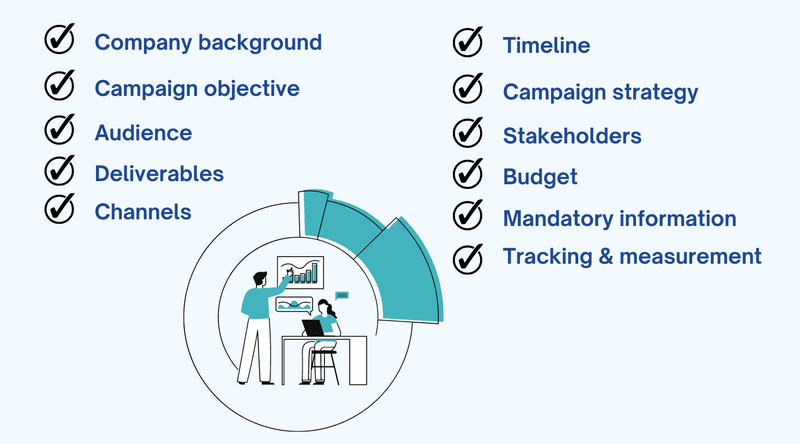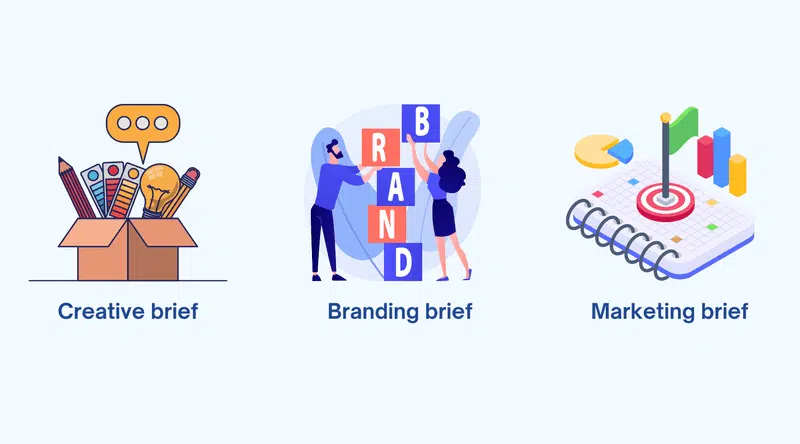Every business, big or small, needs to make its presence felt. The responsibility for making noise about the firm’s offerings lies with the marketing department. Creating the next viral advertisement or generating hype for your company’s marketing efforts is essential. And for that to happen, the foundation of your marketing efforts needs to be firm. A marketing brief plays a vital role in that foundation. This might sound highly cliched but starting any marketing activity without a clear brief is like shooting an arrow in the dark.
Table of Contents:
- What Is a Marketing Brief?
- How To Write A Marketing Brief?
- Marketing Brief Template Or Marketing Campaign Brief Template
- Why Should You Write a Marketing Brief?
- What Is Creative Brief In Marketing?
What Is a Marketing Brief?
A marketing brief is a game plan or a blueprint of a marketing campaign. It provides the framework for how to achieve your marketing goals and objectives. The marketing brief makes sure that there is no disconnect within various teams.
Additionally, it prevents teams from working in silos. Also, a marketing brief helps inform the broader team about the expected outcomes. Moreover, a well-written marketing brief ensures alignment with the overall results.
The marketing brief is a document that can make or break a marketing campaign.
Process Of Creating A Marketing Brief
Prior to creating a marketing brief, all the stakeholders must have clarity on their roles. This is very important to the smooth execution of the campaign.
The marketing brief must be written lucidly and easy to follow. This means that the team must avoid jargon and acronyms.
The flow of the marketing brief has to inform and engage the reader. In the marketing brief, the aim must be to answer the questions – What, Why, How, Where, and When. Also, the marketing brief must be relevant, to the point, and factual.
Every part of the brief has to tie back to the project’s end goal.
How To Write A Marketing Brief?
What to Include in Your Marketing Brief?
The first thing you should do before creating your own marketing brief is to get some information about your company, its products, and its target market.
You can find out this information online by conducting an online search or by talking to your mentor. If you need more help finding the information you need, contact a professional.
When you have your information compiled and ready, it’s time to start writing!
Your marketing brief will include different sections that are usually broken down into headings of key points.
For example, the introduction could be broken down into the company’s mission statement, what they are selling, why they are selling that particular product/service, and how they plan to sell it.
The body of the document will include all the important information about what you want people to know about your business such as their costs and revenues, how many people they serve, their current location, and partnerships with other companies.
The conclusion section should summarize everything about what your company does and why it succeeds so well in its field.
To write a great marketing brief, make sure to include all of these key points as well as share some additional insights from your company on why it was successful in previous campaigns or how it plans on growing its business moving forward.
Marketing Brief Template Or Marketing Campaign Brief Template
A marketing brief is a type of business plan that includes information about your company, its products, and its target market.
It’s a template for writing the different sections of your marketing plan, especially if you want to track your progress and keep everything organized.
You can find a variety of marketing brief templates on the internet or in books about planning your business. However, most marketing briefs are generic and not specific to your business needs and objectives. You might find several marketing briefs on the web that don’t apply to you.
Therefore, it’s not enough just to find one marketing brief template to use as a starting point for creating your own. That’s why we create a generic marketing brief template that can be certainly used by your and many other businesses.
Let us look at the critical elements of the marketing brief template.

A Brief Background About The Company
There are many situations where external people such as designers, copywriters, or entire teams from marketing agencies are involved in a campaign. Make sure to include all the essential details, such as the core business of the firm, its mission, vision, and values. This helps everyone involved in the project to get an idea about the firm.
The Objective Of The Campaign
This part of the marketing brief answers the question ‘Why ?’ Why are you carrying out this campaign? Does the organization want to:
- Increase brand awareness
- Get registrations for a significant event
- Obtaining leads for the sales team
- Increase your follower count on social media
- Drive sales of a particular product
But one must remember that you must be specific in defining these targets, so instead of saying something generic like ‘ Drive Sales,’ the goal must be to drive sales up by 10%.
Audience
Who you are trying to reach through your campaign is yet another essential part that you need to address.
Are the end-users your target market? Or is it other businesses? What are the incomes, spending habits, age, beliefs, etc., of your audience? Also, make sure to create buyer personas and segment your audience. This will help your team understand the mindset of the people buying their products. Also, it will help them to devise a suitable marketing strategy.
Deliverables
Deliverables are the assets that are needed in a marketing campaign. These could be anything from videos, social media posts, flyers, brochures, whitepapers, logo designs, and email copy. When it comes to deliverables, it is essential to keep in mind that to mention the following:
- Quantity
- Specifications such as format and length
Channels
Now that you have decided on the target audience, it is time to work on the best channels to reach them. The choice of media will help you in reaching the audience efficiently.
These channels could involve social media, email marketing, television advertising, and print ads. Moreover, they could include push notifications as well. Or there could arise a situation where the firm might be looking to explore Out Of Home (OOH) advertising.
Also, there could be a discussion on adopting an omnichannel approach as well. Finalizing the proper channels helps channel (pun intended!) the team’s efforts in the right direction.
Timeline
Launching a marketing campaign is a cross-functional effort. Sometimes, the launch dates of the campaign might not be finalized. However, it is ideal to have a plan with tentative dates in place.
Also, one might not know how long it takes for other teams to complete a task. So, it makes sense to establish timelines right at the beginning of the project. Also, it is preferable to have some buffer time in case of emergencies.
Campaign Strategy
This is the most pivotal part of your marketing brief. This is so because you will include details such as market research data, competitor presence, and analysis. Also, you will go ahead and describe the method you are adopting in this campaign.
Furthermore, you will explain why you adopt a particular approach and whether it differs from your competition.
Stakeholders
In this part of the marketing brief, you will have to add the details of everyone that is associated with the project or campaign. This list can include the CMO, product team, website team, social media team, brand, and content marketing team.
This section must clearly outline the roles, responsibilities, and workflow. Also, one needs to mention the final approving authority for each campaign stage.
Budget
The budget is a crucial parameter in determining the ROI of marketing activity. Allocate budget keeping in mind various factors such as :
- historical data
- duration of the campaign
- mode of spending
- Target geographies
Mandatory Information
To complete this portion of the marketing brief, you will need to work closely with different teams such as legal, HR, and procurement. Mandatory information includes and is not restricted to:
- Terms and Conditions
- Legal Requirements
- Project deliverables
- Disclaimers
- Use of logos
- Personally Identifiable Information [PII] such as phone numbers or email addresses
Tracking and Measurement
This section will contain the qualitative and quantitative goals of the project. Various KPIs that have to be achieved will be listed here. Review the progress of the campaign periodically using the parameters mentioned here. Also, at the end of the campaign, compare the actual results with the expected ones to determine whether the campaign was a success or not.
Why Should You Write a Marketing Brief?
The point of a marketing brief is to give shape and coherence to those ideas that have come out from those countless brainstorming sessions. Writing a marketing brief helps you understand the campaign and its objectives better.
Also, you will be able to come up with a structured approach to the campaign. This clarity of thought will help you set realistic expectations from all stakeholders.
How Is A Marketing Brief Different From Other Briefs?

People tend to confuse a marketing brief, a creative brief, and a branding brief. Let us look at the difference between them here.
A creative brief is a document shared either with the internal design team or an agency. This contains the possible ideas that can be executed for the promotional campaign.
What qualities define (or don’t define) your brand? A branding brief describes the identity of your brand. It explains the vision, values, and core driving force behind your brand. A thorough brand brief helps establish the direction, purpose, and positioning of your firm.
However, a marketing brief contains the various milestones, deliverables, and goals that pertain to a particular project.
What Is Creative Brief In Marketing?
A marketing campaign brief is similar to a creative brief. In the same way, a creative brief is a document that outlines the purpose and goals of a particular marketing campaign to support the planning and execution of the creative piece of the marketing campsign. It also includes the specific objectives and target markets.
A creative brief outlines the objectives, goals, and targets of your marketing creatives. It helps you to stay focused and on track as you work on your creative development.
A creative brief in marketing can be helpful in a few different ways.
- First, it can help you to stay focused on your goals. A creative brief can help you to understand your target market and what motivates them. This can help you to create a marketing campaign that is relevant to them.
- Second, a creative brief can help you to create a budget for your project. This can help you to stay within your budget while still achieving your goals.
- Finally, a creative brief can help you to track your progress toward your objectives. This can help you to make adjustments to your creatives as needed.
In short, a creative brief is a helpful document that support you achieve creative and communication goals in your marketing campaign.
In Conclusion

Creating a marketing brief at the outset of a new campaign helps in several ways. Firstly, it helps set measurable end goals. Well-defined end goals ensure that your team does not lose sight of what is important. Also, the plans are the driving force behind the campaign’s strategy.
A marketing brief also helps external agencies get a high-level view of the business. Also, it assures the firm’s leaders that things are not being carried out in an ad-hoc manner. Moreover, the marketing brief document is the one place where any team can get all the information related to particular marketing activity.
Since a marketing brief has inputs from cross-functional teams, all teams are aware of the process and outcomes. This ensures that there are no uncomfortable questions from leadership at the fag end of the campaign.
However, this does not mean that a marketing brief solves all problems. Given the nature of marketing, there are bound to be hiccups and digressions. And this means that the marketing brief cannot be a document set in stone.
It needs to be dynamic to reflect the progress and challenges of the team properly. A dynamic marketing brief that is regularly updated will ensure the campaign’s progress despite any obstacles or delays.

Ranu Kumari is a Professional Writer and a Marketing enthusiast who currently runs her own Marketing Consultancy, LatitudeBOX. She has written promotional articles for multiple brands and has published her work in Scopus indexed journals. She is passionate about expressing her thoughts and ideas to connect with her readers in a voice that they understand.
